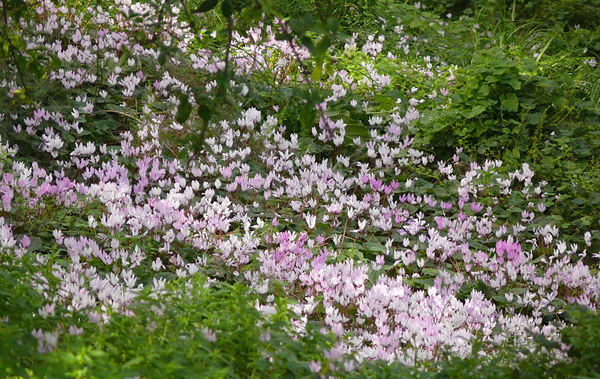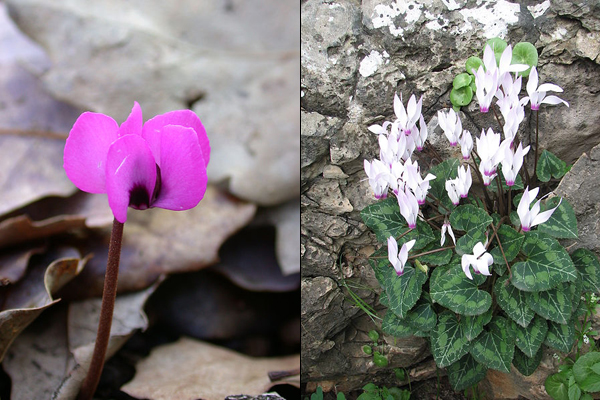Despite the freakishly cold weather we’ve experienced so far this winter — and winter is far from over — the Cyclamen has made its annual appearance.
“Bashful” is a typical description of this genus of the Primrose family, probably because the flower appears to be hanging its head and its preference for shaded and rocky areas. The “rakefet”, as its known in Hebrew, can grown singly or as a carpet of blooms.

Photo by MathKnight and Zachi Evenor via Wikimedia Commons
As the popular 1950s Israeli song goes, “From under a rock, a very sweet cyclamen blooms suddenly / And the shining sun kisses and decorates her with a pink crown / ‘Cyclamen, cyclamen’ the bird twitters, ‘Peek at me for a moment’ / [But] the glorious cyclamen hides within the rock / staying hidden from every living being.” (The complete lyrics and a recording of the song are available at Zemer.co.il, an online collection of early Israeli popular songs).
There are many different species of cyclamen; the ones common to Israel are the Cyclamen coum (pictured left) which in Hebrew is known as “Greek cyclamen” (but should not be confused with the Cyclamen graecum that actually grows in Greece), and Cyclamen persicum or “Persian cyclamen” (pictured right) — a misnomer as it doesn’t really grow in Persia at all.

Photos by Gideon Pisanty (left) and Hanay (right) via Wikipedia
According to the Flowers in Israel website (which has some stunning photos as well), the best place for cyclamen spotting is Givat HaRakafot (Cyclamen Hill), part of the Ramot Menashe Park in the Beit She’an Valleys. “In 1950 a pine forest was planted and a few years later cyclamen started to grow…”

Photo by Zina Sheick-Yousif via Pikiwiki
The rakefet is a protected species and one of the success stories of the Society for the Protection of Nature in Israel – SPNI’s campaign to stop wildflower picking and save the country’s wildflowers from extinction.
However, according to Wikipedia citing the 2006 report, A Phyloclimatic Study of Cyclamen, “Cyclamen diversity in the Mediterranean has been studied extensively to understand how the species remain distinct and how they have reacted to the dramatic climate changes in the region. Certain climate change models suggest many species could become extinct in their current range within the next 50 years.” So, if you’ll pardon the following play on words, the poor bashful little cyclamen is not out of the woods yet.

Photo by MathKnight via Wikipedia Commons
For more information about Cyclamen, visit the Cyclamen Society website. For a database of information, maps, presentations and articles related to wildflowers visit Flora of Israel Online, a project of the Hebrew University of Jerusalem.
Images courtesy of Wikipedia, Wikimedia Commons and Pikiwiki – Free Image collection of Israel














